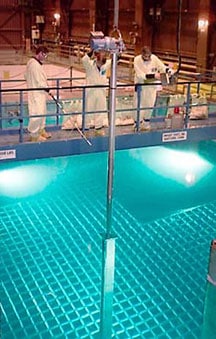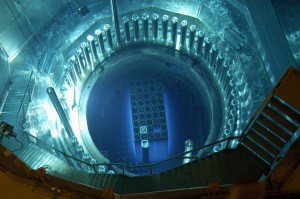
A spent fuel pool (SFP) storage pool for spent nuclear fuel from nuclear reactors. A spent fuel pool may be located inside the containment building or the fuel building (outside the containment building). When located outside the containment building, the two areas are connected by a fuel transfer system which carries the fuel through a normally closed opening in the reactor containment. In this case, spent fuel is removed from the reactor vessel by a manipulator crane and placed in the fuel transfer system. In the spent fuel pool, the fuel is removed from the transfer system and placed into storage racks. After a suitable decay period, the fuel can be removed from storage and loaded into a shipping cask for removal from the site. Spent fuel pools are typically 12m or deeper, with the bottom equipped with storage racks designed to hold fuel assemblies removed from the reactor. A reactor’s pool is specially designed for the reactor where the fuel was used and situated at the reactor site.
Shielding of Spent Fuel in Spent Fuel Pool
It must be noted that irradiated fuel is due to the presence of a high amount of radioactive fission fragments and transuranic elements that are very hot and very radioactive. Reactor operators must manage the heat and radioactivity that remains in the “spent fuel” after it’s taken out of the reactor. In nuclear power plants, spent nuclear fuel is stored underwater in the spent fuel pool on the plant, and plant personnel moves the spent fuel underwater from the reactor to the pool. Over time, as the spent fuel is stored in the pool, it becomes cooler as the radioactivity decays away. After several years (> 5 years), decay heat and radioactivity decrease under specified limits so that spent fuel may be reprocessed or interim storage.
As was written, shielding of the spent fuel pool is ensured by:
- the design of the spent fuel pool (water and concrete shielding),
- the design of the surrounding working area
- requirements on the water level in the pool,
Spent fuel pools are fitted with stainless steel and aluminum racks that hold the fuel assemblies and are lined with stainless steel to prevent leaking. No drains would allow the water level to drop or the pool to become empty. The plants have a variety of extra water sources and equipment to replenish the water that evaporates over time or in case of a leak. Plant personnel is also trained and prepared to respond to a problem quickly. The water serves two purposes: it cools the fuel and shields workers at the plant from radioactivity. Although water is neither high density nor high Z material, it is commonly used as a gamma shield. Water provides a radiation shielding of fuel assemblies in a spent fuel pool during storage or during transport from and into the reactor core. Although water is a low-density and low Z material, it is commonly used in nuclear power plants because these disadvantages can be compensated with increased thickness.
The minimum water level in the fuel storage pool meets the assumptions of iodine decontamination factors following a fuel handling accident. The specified water level shields and minimizes the general area dose when the storage racks are filled to their maximum capacity. The water also provides shielding during the movement of spent fuel. But it also provides the coolant required for cooling spent fuel.
Spent Fuel – Cherenkov Radiation

Cherenkov radiation is electromagnetic radiation emitted when a charged particle (such as an electron) moves through a dielectric medium faster than the phase velocity of light in that medium.
Cherenkov radiation can detect high-energy charged particles (especially beta particles). In nuclear reactors or a spent nuclear fuel pool, beta particles (high-energy electrons) are released as the fission fragments decay. The glow is visible also after the chain reaction stops (in the reactor). The Cherenkov radiation can characterize the remaining radioactivity of spent nuclear fuel and can be used for measuring fuel burnup.